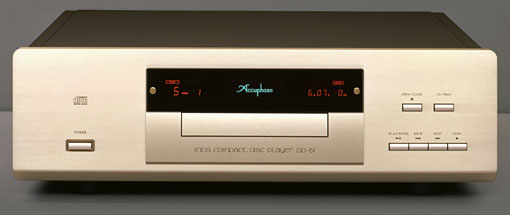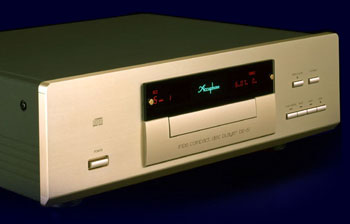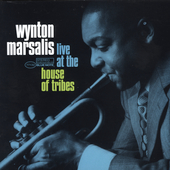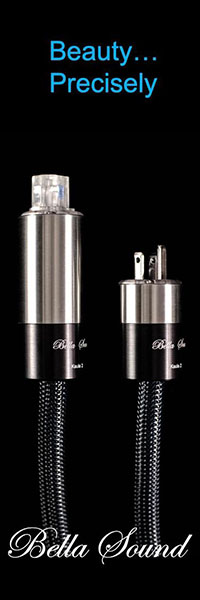Accuphase DP-67 CD Player
| Accuphase DP-67 CD Player |
| A leader in design, excellence in execution |
|
|
|
December 2006 |

Getting my foot inside the door
Accuphase has long been somewhat of a curiosity for me. For as long as I can remember, I have read or heard nothing but praise with regards to their electronic and the company in general. I remember when I first found a dealer that carried the line, I asked one of the salesmen if I could give it a listen. The response the salesman gave me, or asked me, however you want to interpret it, was “why?” Next thing knew I was hustled off to the mid-fi room, faking interest in an Adcom player. I was made to feel as though the Accuphase electronics were beyond me. Since then, no matter how highly Accuphase was spoken of, or how good a review was, I had no desire to discuss the company’s products one way or the other, because of that salesman’s reaction.
But a few months ago, I went to Quintessence Audio, one of the finest audio salons in the Chicagoland area, to visit with its owner, Mick Survance. It had been a while since I’d been there so Mick was kind enough to show me some of the new lines they were carrying. Wouldn’t you know it. There, on the top shelf of one of their audio racks, was a piece of Accuphase equipment, the DP-67 to be exact. At first, I started thinking about that first introduction to the product line in which I was made to feel as though the product was “beyond me” and I really didn’t want to give it a second look. But then I began grinning because: 1) Since joining the staff of Stereo Times I’ve had become more accustomed to spending time with (and owning) gear that previously might have been considered “beyond me” and 2) that salesman was an ass and is no longer selling high-end gear.
But Mick blew away any ill feelings that may have remained by offering to let me take the DP-67 home and listen to it for a weekend. Accuphase was no longer a “mythical” product to me and was now simply just another audio company. Well, make that an audio company who produces some of the most beautifully built and sonically brilliant audio products available anywhere.
I enjoyed my short listening session at the store that evening. I told Mick that one of these days I would have to review something that he sold. Mick responded, “you should review that Accuphase CD player.” I had to make Mick aware that some of my fellow Stereo Times contributors had made attempts to connect with AXISS Distribution, the distributor for Accuphase in North America, and none of them had been able to get access to equipment for review. So as far as I was concerned it was not going to happen. Mick chuckled a little and then calmly suggested that I contact Arturo Manzano at AXISS Distribution, and ask him if I could do a review. I still figured it would be a waste of time, but so be it. I sent Arturo an email but heard nothing for two weeks and began arranging other review assignments. Then finally, I received an email from Arturo saying he’d like for me to review the DP-67 that Mick and I had talked about. I was surprised, to say the least, but happy to have the opportunity to review a piece of equipment from this enigmatic company. You won’t find a lot of Accuphase equipment reviewed much outside of Japan because they are very discriminating as to whom they send their equipment to for a review so I considered myself very fortunate, fortunate to spend time with this piece that is. Whether or not I feel fortunate with an extended listening experience was yet to be seen.
Come on in and take a seat
 When the DP-67 arrived, I was greatly impressed by how ruggedly it was packed. Everything about this solid-state player exudes class and high quality. The fit, finish and functionality of the DP-67 rivals, if not exceeds, that offered by the best of the Esoteric players, and that’s saying something. The DP-67 has the familiar black chassis with thick champagne gold faceplate that epitomizes the Accuphase aesthetic. It weighs in at just over 36lbs and the build quality is even more breathtaking up close. The transport mechanism is smooth and quiet, even more so than the already excellent VRDS transport used on the Esoteric UX-3. The faceplate is clean and uncluttered having an attractive, colorful display, six pushbuttons, and an on/off switch. The display is easy to read from 12-15 feet away and probably more as I don’t believe anyone else’s eye site is as bad as mine. The display is black and utilizes amber colored alphanumeric characters with the “Accuphase” name in the center of it done in what looks to be a turquoise blue-ish color.
When the DP-67 arrived, I was greatly impressed by how ruggedly it was packed. Everything about this solid-state player exudes class and high quality. The fit, finish and functionality of the DP-67 rivals, if not exceeds, that offered by the best of the Esoteric players, and that’s saying something. The DP-67 has the familiar black chassis with thick champagne gold faceplate that epitomizes the Accuphase aesthetic. It weighs in at just over 36lbs and the build quality is even more breathtaking up close. The transport mechanism is smooth and quiet, even more so than the already excellent VRDS transport used on the Esoteric UX-3. The faceplate is clean and uncluttered having an attractive, colorful display, six pushbuttons, and an on/off switch. The display is easy to read from 12-15 feet away and probably more as I don’t believe anyone else’s eye site is as bad as mine. The display is black and utilizes amber colored alphanumeric characters with the “Accuphase” name in the center of it done in what looks to be a turquoise blue-ish color.
The six pushbuttons sit to the right of the display and handle a full range of transport functions. There are two buttons on the top row. One is to “open/close” the disc tray and the other is a “CD/Proc” button for switching the DP-67 from being a CD player to being a digital processor. The bottom four buttons are for “play/pause”, “skip backward”, “skip forward” and “stop”. One of the nice features of the DP-67 is that it can double as a digital processor via its digital inputs. The rear panel contains both balanced and single ended outputs, a digital output, the previously mentioned digital input, and the IEC connector for using your choice of power cords. If you have an upgraded cord to use, you will only enhance the musical performance of the player. I had very good results, and did most of my listening, with the DCCA Musical Essence power cord and obtained even better results with the Sunny Cable Technology SP-1000 power cord. For absolute magic, the Dynamic Design THB gave me the best results of any of the power cords I tried on the DP-67.
Using the remote control is very intuitive. It’s easy to read, and mirrors the front panel functions and many others. You have the basic track selection functions but the option of variable output allows you to mute and control the volume output of the DP-67. This is a neat feature if you’re like me and don’t use a remote controlled preamplifier.
Other features of the DP-67 include their MDS++ D/A converter, which is said to achieve minimum distortion along with superb S/N ratio measurements. The DP-67 also uses a jitter-free high performance digital demodulator, a 3-pole analog filter with “outstanding” phase characteristics, and balanced drive circuitry for servo motors. Arturo also mentioned that Accuphase guarantees all of their written specs. That’s very impressive.
Experiencing the Accuphase sound
I had heard so many positive things about Accuphase over the years that I feared my expectations might be too high and that the DP-67 would only serve to let me down. But if everything I had heard and read about this company was right, then this was going to be a sonic treat beyond my imagination. Thankfully, the latter ruled my days with the DP-67. As soon as I queued up the first disc and the music started to play, I cocked my head to the side as if to make sure that each of my ear canals were getting every nugget of sound and whispered to myself, “damn that sounds good.” The first thing that jumps out at you is how musical the DP-67 is. I’ve never heard a digital source as analog-sounding as this. If you can remember the first time you heard some really good vacuum tube electronics and the feeling that you were experiencing your favorite recordings in the most lifelike manner that you had ever heard before, that’s what you’ll experience from the DP-67.
Tonally, the DP-67 sounds neutral, warm, and transparent. That should be expected from a unit of this pedigree but far too often is not reached with comparably priced designs. It has a level of presence, dimensionality and stage width that is jaw-dropping and still has no tube noise or softening of transient response. The upper frequency performance is certainly good, though not the best I’ve heard in terms of having a “sense of air,” but if you think about it, can anyone truly reproduce the sound of air, particularly from a live event? What you do get in the upper frequencies is detail, detail, detail (such as the decay when a triangle or cymbal is struck) and accurate timbre. Listen closely to percussive instruments being struck and notice the echo as the note propagates naturally. This is something that the DP-67 does better than most of the CD players I’ve listened to and characterizes its wonderful midrange performance.
The separation of instruments and the ability to follow individual lines out of a large ensemble are also excellent. The tonal colors of instruments come through vividly and really make it easy to identify different instruments and the distinctive artists playing them. It’s hard to describe performance parameters like transient response, pacing, drive, tunefulness, etc., with the DP-67. It all falls into place so naturally and so reminiscent of the real thing that you don’t get caught up into listening for those things, especially after the first few discs. The important thing is the DP-67’s ability to answer the call when it comes to enjoying the music and the performers’ ability to communicate to you the vibe or the feeling that’s being shared with those who are listening. For me, this is paramount.
The bass performance of the DP-67 is also excellent. No shock there. The upper bass performance supports the midrange effortlessly and the transition from one to the other is seamless, adding to the sense of realism.  The midbass is tight and never boomy unless the disc was recorded that way. (Try as I may I could not do anything to tame neo-soul superstar D’Angelo’s CD Brown Sugar [Virgin]. The artist and recording engineer apparently have a predilection for saturating great musical compositions with almost unmusical bass lines.) The DP-67’s deep bass performance extends well into the nether regions, and if your speakers can extend below 32 cycles, your room will be fed a signal capable of making the room shudder.
The midbass is tight and never boomy unless the disc was recorded that way. (Try as I may I could not do anything to tame neo-soul superstar D’Angelo’s CD Brown Sugar [Virgin]. The artist and recording engineer apparently have a predilection for saturating great musical compositions with almost unmusical bass lines.) The DP-67’s deep bass performance extends well into the nether regions, and if your speakers can extend below 32 cycles, your room will be fed a signal capable of making the room shudder.
 On Wayne Shorter’s wonderful CD Alegria[Verve], listen to the Heitor Villa-Lobos composition, “Bachianas Brasileiras No.5.” This intriguing arrangement includes three cellists, one playing lead, one playing the melody, and the third cellist is plucking strings. Shorter, as always, is a treat to listen to with any of the saxophones he’s playing. The entire disc left me wanting to hear more, but especially when played on the DP-67. Wynton Marsalis’ CD Live at the House of Tribes [Blue Note] has a wealth of live hall sounds, glasses clinking and patrons talking, hooting, and cheering (a little too much at times).
On Wayne Shorter’s wonderful CD Alegria[Verve], listen to the Heitor Villa-Lobos composition, “Bachianas Brasileiras No.5.” This intriguing arrangement includes three cellists, one playing lead, one playing the melody, and the third cellist is plucking strings. Shorter, as always, is a treat to listen to with any of the saxophones he’s playing. The entire disc left me wanting to hear more, but especially when played on the DP-67. Wynton Marsalis’ CD Live at the House of Tribes [Blue Note] has a wealth of live hall sounds, glasses clinking and patrons talking, hooting, and cheering (a little too much at times).  This all adds to the “you are there” experience that went into the recording of this disc. With the DP-67’s ability to transport you to the recorded event, you can close your eyes feel like you’re seated at a table somewhere in the middle of that raucous audience, and close enough to the stage that you can hear the performers clearly. Jane Monheit’s vocalizations on “Honeysuckle Rose” and “Misty”, from Mark O’Connor’s Hot Swing Trio’s In Full Swing [Sony Odyssey] CD, continues to be a favorite. All of the performances on this disc are offered up with an increased feeling of realism, but Ms. Monheit’s performance in particular, stands out because the purity of her vocals are combined with the excellent level of stage presence that the DP-67 offers.
This all adds to the “you are there” experience that went into the recording of this disc. With the DP-67’s ability to transport you to the recorded event, you can close your eyes feel like you’re seated at a table somewhere in the middle of that raucous audience, and close enough to the stage that you can hear the performers clearly. Jane Monheit’s vocalizations on “Honeysuckle Rose” and “Misty”, from Mark O’Connor’s Hot Swing Trio’s In Full Swing [Sony Odyssey] CD, continues to be a favorite. All of the performances on this disc are offered up with an increased feeling of realism, but Ms. Monheit’s performance in particular, stands out because the purity of her vocals are combined with the excellent level of stage presence that the DP-67 offers.
For comparison sake
I made some interesting observations while comparing the previously reviewed Esoteric UX-3 and my own DV50S with the DP-67. Let me preface these comments by saying that they are based on the players’ ability to play redbook CDs and some discs that I’ve made with my trusty little CD-R. The DP-67, at $6,500 competes most favorably to the $8,500 Esoteric UX-3 in that all too important $6K-10K price point. Both Esoteric players seemed to have a little more upper frequency extension, but not by much. The Esoteric players also have slightly more output and, at any volume level, may seem to have more bass output than the DP-67. But, I’d also have to say that the DP-67’s bass is tighter with less bloat or over emphasis. It’s sort of that “six of one or half dozen of the other” feeling. But midrange performance goes to the Accuphase player, hands down. It’s not that the UX-3’s midrange isn’t good because it really is very good. It just doesn’t have the same magic that the DP-67 possesses in terms of dimensionality and presence. I haven’t experienced any other player, so far, that portrays an event that was recorded on a CD with the level of realism that the DP-67 does.
Final thoughts
Doing this review of the Accuphase DP-67 CD player helped me out in a lot of different ways, especially once I was able to get over my initial experience from some 20 years ago when I was subjected to a breach of dealer etiquette. I can say with full confidence and firsthand experience that Accuphase is a classy organization that has an excellent dealer network, good support for their customers, and makes some of the best built and excellent sounding equipment, period. The DP-67 is definitely amongst the best pieces of equipment that I’ve reviewed. Looking at the entire package overall, I would call the DP-67 a bargain even at its price point and is why I give it my highest recommendation.
Michael Wright
____________________
Specifications:
Accuphase DP-67
Frequency Response: 4.0 – 20,000 Hz +/- 0.3dB
Total Harmonic Distortion: Max 0.001% (20-20,000 Hz, 24 bit input)
Signal to Noise Ratio: 114 dB or better
Dynamic Range: 110 dB or better (24 bit input)
Channel Separation: 110 dB or better
Price: $6,500.00
Accuphase Laboratory, Inc.
2-14-10 Shin-ishikawa, Aoba-ku
Yokohama 225-8508 Japan
Tel. 81-45-901-2771
Fax. 81-45-901-8959
U.S. Distributor
AXISS Distribution, Inc.
17800 South Main St., Suite 109
Gardena, CA 90248 U.S.A.
Tel: (310) 329-0187
Fax: (310) 329-0189
Website: http://www.axissaudio.com/
E-Mail: info@axiss-usa.com
“AXISS Distribution Inc. also covers the CANADIAN market”.
![]()
Don’t forget to bookmark us! (CTRL-SHFT-D)
One thought on "Accuphase DP-67 CD Player"
Leave a Reply
Stereo Times Masthead
Publisher/Founder
Clement Perry
Editor
Dave Thomas
Senior Editors
Frank Alles, Mike Girardi, Russell Lichter, Terry London, Moreno Mitchell, Paul Szabady, Bill Wells, Mike Wright, and Stephen Yan,
Current Contributors
David Abramson, Tim Barrall, Dave Allison, Ron Cook, Lewis Dardick, John Hoffman, Dan Secula, Don Shaulis, Greg Simmons, Eric Teh, Greg Voth, Richard Willie, Ed Van Winkle, Rob Dockery, Richard Doran, and Daveed Turek
Site Management Clement Perry
Ad Designer: Martin Perry





Still using my accuphase dp67 now in 2025 and sounds wonderful 😊